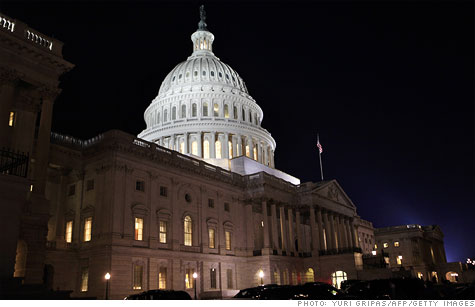Search News

The federal government is on track for another year of $1 trillion-plus deficts.
NEW YORK (CNNMoney) -- The federal government racked up an almost $780 billion deficit in the first six months of the fiscal year, according to new data from the Congressional Budget Office.
While that's quite a large number, it's actually $53 billion less than the same period last year, when the deficit totaled $829 billion.
The deficit is the annual gap between what the government spends and what it takes in. Accumulated deficits make up the national debt, which is currently north of $15 trillion.
The lower deficit for the first six months of the fiscal year is a product of slightly less government spending and an increase in revenues, or money collected by the government.
The CBO attributed about two-thirds of the $46 billion -- or 4.5% -- increase in revenue to corporations paying more in taxes. The government also collected more income tax from individuals. That's good news, as increased income tax collection indicates an improving economy and higher incomes for workers.
Total government spending dropped by $7 billion -- a very small number when compared to the total budget. But certain programs fared better than others.
Spending on Medicaid dropped $24 billion, and the government spent $15 billion less on unemployment benefits due to improvement in the job market in recent months. Defense spending declined by $9 billion.
Spending on Fannie Mae and Freddie Mac increased by $12 billion. Social Security benefit payments rose by $18 billion and spending on Medicare jumped $6 billion.
Last year, the federal government closed out its fiscal year in October with an estimated deficit of $1.3 trillion. That was the third straight year that the deficit exceeded $1 trillion.
The deficit will do so again this year -- marking the fourth straight year of $1 trillion-plus deficits.
This year, exactly how much money the government is spending relative to revenues is extremely important.
The deal cut this summer to end the debt ceiling standoff provided for a $2.1 trillion increase in the country's legal borrowing limit, which now stands at $16.394 trillion.
At the time, it was estimated that such an increase could carry the Treasury Department safely beyond the contentious presidential election season and into early 2013.
But now that Congress has extended the payroll tax cut, emergency unemployment benefits and the so-called Medicare doc fix -- only some of which was paid for -- there is a greater chance that U.S. borrowing could reach the debt ceiling sooner.
It's possible that the limit could be reached smack dab in the middle of the fiscal firefight that Congress is expected to have over the expiring Bush tax cuts. That's to say nothing of Election Day, which falls on Nov. 6 this year.
Should the limit approach, the Treasury Department could still avert a U.S. default by employing "extraordinary measures" -- such as suspending investments in federal retirement funds.
So even if Treasury is at risk of hitting the ceiling at the end of November, it's possible that its moves could take the risk of default off the table until early 2013.
| Overnight Avg Rate | Latest | Change | Last Week |
|---|---|---|---|
| 30 yr fixed | 3.80% | 3.88% | |
| 15 yr fixed | 3.20% | 3.23% | |
| 5/1 ARM | 3.84% | 3.88% | |
| 30 yr refi | 3.82% | 3.93% | |
| 15 yr refi | 3.20% | 3.23% |
Today's featured rates:
| Latest Report | Next Update |
|---|---|
| Home prices | Aug 28 |
| Consumer confidence | Aug 28 |
| GDP | Aug 29 |
| Manufacturing (ISM) | Sept 4 |
| Jobs | Sept 7 |
| Inflation (CPI) | Sept 14 |
| Retail sales | Sept 14 |